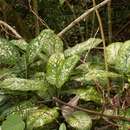en
names in breadcrumbs


Dieffenbach seguine, also known as dumbcant,[1] or tuftroot,[2] is a species of Dieffenbachia native to the tropical Americas—from southern Mexico, through Central America, to northern South America and Brazil.[1] It is also native to several Caribbean islands, including Puerto Rico.[1]
The herbaceous perennial grows 3 feet (0.91 m) to 10 feet (3.0 m) in height and 2 feet (0.61 m) to 3 feet (0.91 m) in width.[3] The plant's leaves are large and green, and often with variegated white patterns. Like other Dieffenbachias, the sap is toxic. It has showy white flowers.[3]
Dieffenbachia seguine is cultivated as an ornamental plant in temperate shade gardens and as a potted house plant.[3] Cultivars emphasize different patterns of variegation.

Dieffenbach seguine, also known as dumbcant, or tuftroot, is a species of Dieffenbachia native to the tropical Americas—from southern Mexico, through Central America, to northern South America and Brazil. It is also native to several Caribbean islands, including Puerto Rico.